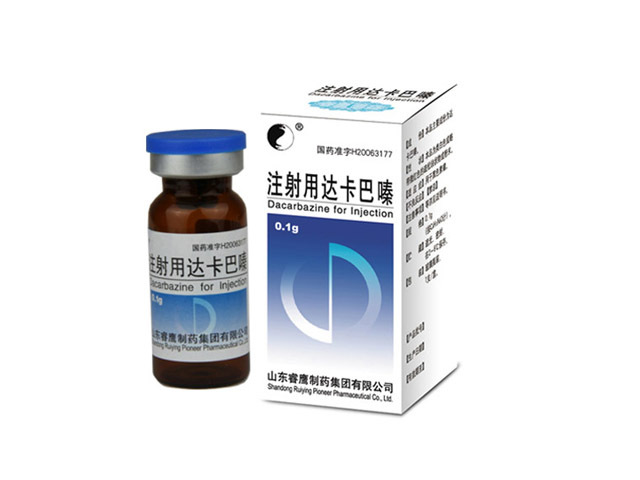Dacarbazine for Injection

Dacarbazine for Injection
English name: Dakarbazine for Injection
Chinese Pinyin: Zhusheyong Dakabaqin
【 Ingredients 】 The main ingredient of this product is Dacarbazine.
Chemical name: 5- (3,3-dimethyl-1-triazene) - imidazol-4-formamide citrate. Abbreviated as DTIC or DIC.
Molecular formula: C6H10N6O ? C6H8O7
Molecular weight: 374.31
Auxiliary material used: citric acid
[Drug Name]
Common name: Dacarbazine for injection
English name: Dakarbazine for Injection
Chinese Pinyin: Zhusheyong Dakabaqin
Ingredients
Main ingredients of this product: Dacarbazine.
Chemical name: 5- (3,3-dimethyl-1-triazene) - imidazol-4-formamide citrate. Abbreviated as DTIC or DIC.
Molecular formula: C6H10N6O ? C6H8O7
Molecular weight: 374.31
Auxiliary material used: citric acid
【 Description 】 This product is a loose block or powder with a white or slightly reddish color.
[Indications] Used for melanoma.
【 Specification 】 0.1g (calculated according to C6H10N6O)
[Usage and Dosage]
Intravenous infusion, this product should be prepared before use and used within 2 hours:
Take 2.5-6mg/kg or 200-400mg/m2, dissolve in 10-15ml of physiological saline, dilute with 250-500ml of 5% glucose injection, and then drip. Drip for more than 30 minutes, once a day, for 5-10 consecutive days as a course of treatment, with a general interval of 3-6 weeks for repeated administration.
Single high dose: 650-1450mg/m2, once every 4-6 weeks.
Intravenous injection: 200mg/m2 once a day, used continuously for 5 days, repeated every 3-4 weeks.
Adverse reactions
Digestive reactions: such as loss of appetite, nausea and vomiting, diarrhea, etc., can be relieved or disappear after 2-8 hours.
Bone marrow suppression: can cause a decrease in white blood cells and platelets, anemia, and is more pronounced at high doses. Generally, there is a decrease in blood count within 2-3 weeks of medication, and it can return to normal within 4-5 weeks.
A small number of patients may experience flu like symptoms, such as general discomfort, fever, and muscle pain, which can occur 7 days after medication and last for 1-3 weeks. May have facial numbness and hair loss.
Local reaction: There may be a vascular stimulation reaction at the injection site.
Occasional liver and kidney dysfunction was observed.
Taboos
Prohibited for patients with chickenpox or herpes zoster.
Prohibited for individuals with a history of severe allergies.
Prohibited for pregnant women.
【 Precautions 】
Patients with liver and kidney dysfunction or infection should use this product with caution.
Due to the extreme instability of this product to light and heat, it is prone to turning red when exposed to light or heat, and is unstable in water. After being placed, the solution turns light red. Temporary preparation is required, and immediate injection is required after dissolution. And try to avoid light as much as possible.
Interference with diagnosis: When using this product, it can cause temporary elevation of serum urea nitrogen, alkaline phosphatase, alanine aminotransferase, aspartate aminotransferase, and lactate dehydrogenase.
Active virus vaccination is prohibited during medication.
The intravenous infusion speed should not be too fast.
Prevent drug leakage and avoid irritation to local tissues.
During medication, serum urea nitrogen, creatinine, uric acid, serum bilirubin, alanine aminotransferase, aspartate aminotransferase, and lactate dehydrogenase should be regularly checked.
【 Pregnant and lactating women's medication 】
It has teratogenic and mutagenic effects, and may have carcinogenic effects. It is contraindicated for pregnant women.
Breastfeeding women should stop breastfeeding during medication.
[Children's medication] This experiment was not conducted and there are no reliable references available.
[Elderly medication] This experiment was not conducted and there are no reliable references available.
Drug interactions
When used in combination with other bone marrow inhibiting drugs or radiation therapy, the dosage of this product should be reduced.
[Drug overdose] This experiment was not conducted and there are no reliable references available.
Pharmacology and Toxicology
Pharmacology
This product is a precursor for purine biosynthesis, which can interfere with purine biosynthesis; After entering the body, liver microsomes demethylate to form monomethyl compounds, which have direct cytotoxic effects. Mainly acting on the G2 phase. Inhibition of purine, RNA, and protein synthesis also affects DNA synthesis.
Toxicology
The experimental results show that the acute lethal dose (LD50) of this product for intraperitoneal injection in mice is 815mg/kg ± 50.9mg/kg.
Pharmacokinetics
This product has significant individual differences due to incomplete oral absorption. Dacarbazine is only administered intravenously. It first undergoes N-demethylation in the liver to form a monomethyl form, and then metabolizes into Aminimidazole Carboxamide (AIC) and diazomethane. Active carbon ions are formed from diazomethane. This product has biphasic plasma decline: half-life (t1/2) of 19 minutes and 5 hours. It is quickly excreted by the secretion of renal tubules. Approximately 40% is excreted in an unchanged form within 6 hours, and the main metabolite in urine is AIC.
【 Storage 】 Light shielded, sealed, stored at 2-8oC.
【 Packaging 】 Glass bottle, 1 piece/box.
【 Validity 】 24 months.
[Executive Standard] WS-10001- (HD-0946) -2002
[Approval Number] National Pharmaceutical Approval Letter H20063177


